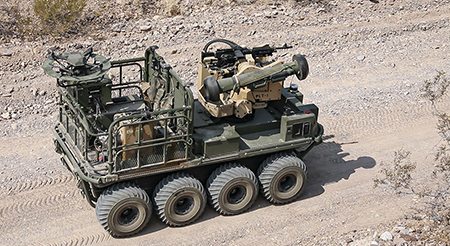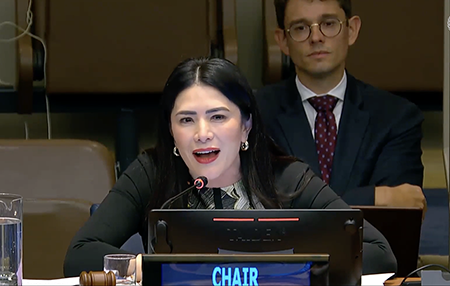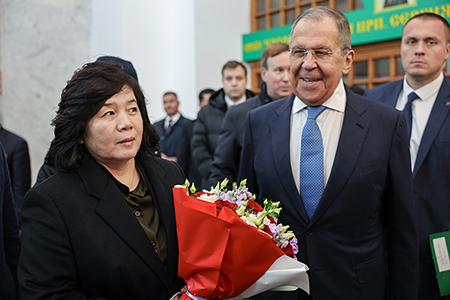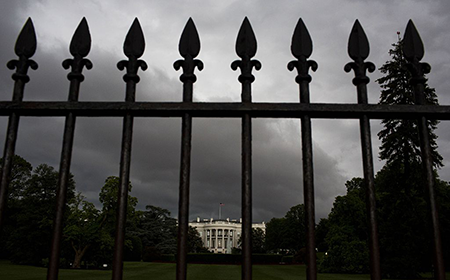Defending the “Guardrails” Against Catastrophe
Inside the Arms Control Association
November 2024
Defending the “Guardrails” Against Catastrophe
The UN General Assembly mandated new international consultations intended to advance slow-moving negotiations on a treaty or agreement that would regulate autonomous weapons systems.
December 2024
By Michael T. Klare
The UN General Assembly mandated new international consultations intended to advance slow-moving negotiations on a treaty or agreement that would regulate autonomous weapons systems.

In a resolution adopted Dec. 2, the assembly said informal talks among member states and nongovernmental organizations should be held in New York in 2025 to consider the dangers posed by autonomous weapons systems, often called “killer robots” by critics, and possible measures for their control.
The vote was 166-3 with 15 abstentions. It quickly followed action by the UN First Committee which approved the resolution 161-3 with 13 abstentions on Nov. 5.
The Campaign to Stop Killer Robots, an umbrella organization for other civil society activists on this issue, described the resolution as a “small step” forward. It expressed disappointment that “the resolution does not reflect the clear desire of the majority of the international community to urgently launch negotiations on a legal binding instrument on autonomous weapons systems.”
In statements submitted to the UN secretary-general pursuant to a 2023 UN resolution on this topic, many governments and nongovernmental organizations expressed frustration that the group of governmental experts created by the Convention on Certain Conventional Weapons to develop international restraints on autonomous weapons systems has not achieved any notable progress after years of deliberation. (See ACT, October 2024.)
Meanwhile, Israel’s reported use of autonomous weapons systems and artificial intelligence (AI) tools in Gaza has “shown the devastating and unacceptable harm that can result from seeking to increase the speed of violence through AI and automation,” the Campaign to Stop Killer Robots said. The group also noted that U.S. and Russian weapons programs show “that countries are already looking to compete for military advantage through increasing autonomy in weapons systems.”
Alexander Kmentt, the director of disarmament, arms control, and nonproliferation in the Austrian Foreign Ministry and a key figure in deliberations on the First Committee resolution, also expressed regret that the final text only authorized two days of consultations and lacked a more explicit focus on crafting international regulations.
But Kmentt welcomed the new venue for discussions. “I believe that the urgency about integrating autonomy into weapons systems is such that we need to really elevate the issue much higher on the political agenda,” he told Arms Control Today.
The expert group discussions “must certainly progress to negotiations on a legally binding instrument as soon as possible but, in addition to this, we also need to generate momentum for the need for regulation in other relevant forums as well, such as the UN General Assembly,” Kmentt said.
Similar to the 2023 UN directive on autonomous weapons systems, the new resolution expresses concern “about the possible negative consequences and impact of autonomous weapon systems on global security and regional and international stability, including the risk of an emerging arms race, [and] lowering the threshold for and escalation of conflicts.” (See ACT, December 2023.)
While noting that considerable international attention has been focused on these dangers by governments and civil society organizations, the resolution warned that the development of autonomous weapons systems has been occurring at a faster pace than efforts to adopt reasonable controls.
The governmental and civil society submissions to the secretary-general also raised concerns that the expert group had not adequately addressed ethical and moral issues raised by the deployment of machine combatants governed by AI with a capacity to take human lives.
To address these concerns, the resolution calls on the secretary-general to facilitate “informal consultations” next year intended to “further the international community’s understanding of the issues involved by discussing the full range of views received, including proposals and relevant aspects raised in the report that may thus far not have been discussed in detail” in the experts group.
The consultations are to be held over a two-day period.
The UN General Assembly First Committee authorized three new initiatives concerning nuclear weapons issues.
December 2024
By Shizuka Kuramitsu
The UN General Assembly First Committee authorized three new initiatives concerning nuclear weapons issues during its annual meeting as it sought to advance a commitment to international peace and security.

The committee, which focuses on disarmament and international security, met from Oct. 7 to Nov. 8 in New York amid rising geopolitical tensions and deepening polarization among states. It adopted 77 draft resolutions altogether, including the three new initiatives related to nuclear weapons.
Among the more significant resolutions was a proposal by Ireland and New Zealand to establish an independent scientific panel on the effects of nuclear war. The resolution was adopted 144-3, with 30 states abstaining, including India, North Korea, Poland, and the United States. France, Russia, and the United Kingdom voted no.
Unlike other multilateral disarmament meetings, the First Committee adopts resolutions by a majority vote, not by consensus. The independent scientific panel will consist of 21 members who will be tasked with examining the physical effects and societal consequences of a nuclear war on local, regional, and planetary scales.
“A new U.N.-mandated expert study assessing and addressing the current knowledge of the effects of nuclear war can spur a better-informed, inclusive and much-needed global debate on what nuclear war means for people and the planet,” physicist Zia Mian of Princeton University, a proponent of the study, wrote in Scientific American on Oct. 28.
“It also would help governments and people in nuclear-armed states better understand the nature, scale and severity of the many catastrophic consequences of nuclear war, not just for adversaries but for everyone, including themselves,” Mian added.
Explaining her country’s vote against the resolution, Camille Petit, France’s ambassador to the Conference on Disarmament (CD), said on Nov. 4 that the study group “would not be able to provide new elements to contribute to understanding of the effects of nuclear war” as the devastating consequences are already well known.
Likewise, David Riley, UK ambassador to the CD, said that the international community “always recognized…the devastating consequences” of nuclear war, thus they are not “persuaded of the utility of the independent scientific panel.”
Bruce Turner, U.S. ambassador to the CD, said that the United States also is “clear-eyed about the consequences of nuclear war” and “skeptical of this resolution or [that] the panel’s findings will help move us toward that goal” of no nuclear use.
Nevertheless, Turner said that the United States is “not opposed in principle to a discussion” and would “carefully consider” U.S. participation in this study group process. He stressed that the resolution mandate “must remain unbiased, evidence based…and not be politicized.”
The other new resolutions on nuclear weapons were less contentious. One, advanced by Brazil and Norway, encourages UN member states to engage in a discussion on the establishment of a group of scientific and technical experts on nuclear disarmament verification. It was adopted 173-1 with two abstentions.
The third resolution, proposed by 46 non-nuclear-weapon states, seeks to “convene a qualified group of up to 25 experts…to prepare a new comprehensive study” on nuclear-weapon-free zones. It was adopted 172-2 with three abstentions. The two countries in opposition were Argentina and Israel.
In addition to the three new nuclear-related resolutions, others focused on the topics of the Biological Weapons Convention, the Outer Space Treaty, and autonomous weapons systems. The full General Assembly began acting on the resolutions on Dec. 2.
The First Committee was chaired by Costa Rica’s UN ambassador, Maritza Chan, who served as the committee’s first female chair. “We can only build true security by working together to address the root causes of violence. We must cooperate, not compete with each other in order to survive and thrive in our dynamic world,” she said.
Chan also spoke of the advances women have made in playing a larger role in the First Committee and disarmament generally. “Throughout the history of our work, we have seen that women and a range of diverse stakeholders have brought important insights, experiences, and knowledge for disarmament. We have also been bridge-builders, bringing people together and finding common ground,” she said.
“I hope that the trend of increasing gender perspectives in our statements and resolutions, and including women in meaningful roles within our delegations, continues to the 80th session and beyond,” added Chan.
North Korea also ratified a mutual defense treaty with Russia, as Japan, South Korea, and the United States announced a new mechanism for monitoring Pyongyang’s sanctions evasion.
December 2024
By Kelsey Davenport
North Korea tested a new long-range missile and ratified a mutual defense treaty with Russia as Japan, South Korea, and the United States announced a new mechanism for monitoring Pyongyang’s sanctions evasion and coordinating regional actions.

The state-run Korean Central News Agency (KCNA) described the new North Korean intercontinental ballistic missile (ICBM) as the “world’s strongest strategic missile” and said the Oct. 31 launch demonstrates the credibility of the country’s nuclear deterrent.
The missile, dubbed the Hwasong-19, is a solid-fueled system that is more powerful than the ICBMs North Korea tested in the past. North Korea already can target the entire continental United States with previously tested ICBMs, but the Hwasong-19 appears designed to carry multiple warheads with independently targetable reentry vehicles. The Hwasong-19, along with the previously tested Hwasong-18, will serve as the “core means” of defending North Korea by “containing the enemies’ acts of aggression and reliably protecting the national security,” according to KCNA.
North Korea launched the missile in violation of UN Security Council resolutions prohibiting its ballistic missile activities.
According to KCNA, North Korean leader Kim Jong Un was present for the launch. Kim said that North Korea’s “rivals’ dangerous tightening of their nuclear alliance” highlights the “importance of strengthening our nuclear forces.”
Prior to the launch, KCNA reported that Kim visited an ICBM base to review the “operational readiness” of North Korea’s strategic missile forces. He called for modernizing missile facilities and reviewing launch procedures to ensure North Korea can “swiftly deliver strategic counterattacks against enemies at any moment.”
Although the UN Security Council met to discuss the launch of the Hwasong-19, the body failed to condemn North Korea, following a pattern of inaction in response to the country’s violations. (See ACT, July/August 2023.)
During the council meeting on Nov. 4, North Korean Ambassador Kim Song justified the test and said Pyongyang will accelerate its nuclear weapons buildup to “counter any threat presented by hostile nuclear-weapon states.” He said the test posed no threat to the region.
Japanese Ambassador Kazuyuki Yamazaki refuted that assessment, telling the council that the launch was “more threatening than ever” and that the missile splashed down in waters near Japan. He urged North Korea to refrain from further launches.
U.S. Deputy Ambassador Robert Wood also condemned the missile launch during the meeting and described it as a “direct violation of multiple Security Council resolutions.” He said that North Korea’s continued missile testing allows the country to identify and address capability gaps to advance its weapons program. Wood accused Russia and China of repeatedly shielding North Korea from “any reprisal” by the council.
Chinese Ambassador Fu Cong told the council that it should focus on “easing rather than exacerbating tensions” in the region and that further pressure will lead to escalation. The key to resolving tensions lies with the United States, he said.
During the meeting, Wood also raised North Korea’s transfer of weaponry to Russia for use in Ukraine and the presence of North Korean troops in Russia. He called North Korea’s weapons exports an egregious violation of Security Council resolutions and said that if North Korean troops “engage in combat or combat support operations against Ukraine,” they will be “legitimate military targets.”
Russian Deputy Ambassador Anna Evstigneeva denied the presence of North Korean military in Russia. She accused the United States of creating a “negative buzz” about North Korea in order to keep “ineffective sanctions measures afloat.” Evstigneeva said North Korea “has every right to apply measures to ensure the security and sovereignty of their country.”
Several days after the Security Council meeting, Russian President Vladimir Putin signed the mutual defense treaty with North Korea that Moscow and Pyongyang announced during Putin’s visit to Pyongyang in June. (See ACT, July/August 2024.) Kim Jong Un ratified the treaty two days later, on Nov. 11.
The treaty includes a provision requiring Russia and North Korea to “immediately provide military” assistance if the other country is attacked. Even though Russia invaded Ukraine, it is unclear if Putin will invoke the treaty’s provisions to request additional North Korean assistance more formally.
Japan, South Korea, and the United States condemned the growing ties between North Korea and Russia in a Nov. 15 joint statement during a trilateral heads of state meeting. The three leaders announced the establishment of a new joint secretariat to coordinate actions and implement shared goals, including security on the Korean peninsula.
The statement committed the three countries to “respond resolutely to any violations or evasions” of UN Security Council resolutions and emphasized the importance of the new multilateral sanctions monitoring team.
Launched in October by 11 states, including Japan, South Korea, and the United States, the team is tasked with monitoring the implementation of Security Council resolutions on North Korea. According to an Oct. 16 press release announcing the new mechanism, the monitoring team will support implementation of council sanctions against North Korea by “publishing information based on rigorous inquiry into sanctions violations and evasion attempts.”
A UN panel of experts previously performed a similar task, but its mandate was vetoed by Russia in March. (See ACT, May 2024.)
OPCW Finds Toxic Chemical Use in Ukraine
December 2024
Investigators for the Organisation for the Prohibition of Chemical Weapons (OPCW) confirmed the presence of a toxic chemical at the site of a September military battle in Ukraine, which is fighting to repel a full-scale invasion by Russia.
In a report issued on Nov. 18 after a technical assistance site visit near the village of Illinka in the Dnipropetrovsk region, the OPCW said that the toxic chemical 2-Chlorobenzylidenemalononitrile, also known as CS, was determined to be present during a confrontation that took place on Sept. 20.
The OPCW expert team collected documentation and digital files and testimonies from first-hand witnesses and received three samples gathered by Ukraine: a grenade shell and two soil samples collected from a trench. Afterward, grenade and soil samples analyzed by two separate OPCW designated laboratories found traces of CS, a riot control agent that is prohibited from being used as a method of warfare under the Chemical Weapons Convention (CWC).
The OPCW visit was requested by Ukraine under Article VIII of the CWC. It came after the Ukrainian Parliament ratified an agreement on privileges and immunities for technical assistance visits between Ukraine and the OPCW Technical Secretariat. (See ACT, June 2024.)
OPCW Director-General Fernando Arias lamented the treaty violation represented by the incident and reiterated the secretariat’s commitment to assisting CWC states-parties in upholding the norm against chemical weapons.
Ukraine asked the secretariat to make the full report public and share it with all states-parties. The report was released one week before the beginning of the annual CWC conference of states-parties, Nov. 25-29 in The Hague.—MINA ROZEI
Floyd Reappointed to Head Test Ban Organization
December 2024
Member states of the Preparatory Commission for the Comprehensive Nuclear-Test-Ban Treaty Organization (CTBTO) have reappointed Robert Floyd as executive secretary for a second term through 2029. The decision was made on Nov. 11.
The Comprehensive Test Ban Treaty (CTBT) has helped keep a lid on nuclear testing for 28 years, but there is increasing talk in the United States and elsewhere of resuming testing.
In a Nov. 12 social media post, Floyd expressed gratitude to the member-states for their trust and support and renewed his commitment to the organization’s goals. “I am truly touched and heartened by the encouragement and confidence you have shown over the past 3.5 years,” Floyd wrote. “I look forward to continuing our work together, advancing our shared mission of a nuclear-test-free world—building a world of peace and security for this generation and generations to come.”
At the Nov. 11 meeting, Floyd shared his vision for the organization’s future and outlined several key priorities, including completion of the CTBTO International Monitoring System, carrying out an on-site inspection field exercise in Sri Lanka to help prove the CTBTO verification regime, and promoting continued diversity within the organization.
Floyd, a former head of the Australian Safeguards and Non-Proliferation Office, has led the CTBTO since August 2021 after an unusually contentious appointment process. (See ACT, June 2021.)—SHIZUKA KURAMITSU
Pentagon Releases Nuclear Employment Report
December 2024
The U.S. Defense Department said it “may be necessary to adapt current U.S. [nuclear] force capability, posture, composition, or size” in an “evolving security environment,” according to a report to Congress released Nov. 15.
The report on U.S. nuclear employment strategy is mandated by law and summarizes changes to the classified nuclear weapons employment guidance developed by the Biden administration in line with the 2022 Nuclear Posture Review. (See ACT, December 2022.)
The report’s statement on the size of the nuclear arsenal is consistent with comments by Pranay Vaddi, senior director for arms control, disarmament, and nonproliferation at the National Security Council, in June that U.S. nuclear forces “may reach a point in the coming years where an increase from current deployed numbers is required.” (See ACT, July/August 2024.)
The report otherwise largely adheres to the nuclear posture review and reaffirms the policy that “the fundamental role of nuclear weapons is to deter nuclear attack on the United States or its allies and partners.” It also restates the U.S. commitment to ensuring that all nuclear plans must be “consistent with the Law of Armed Conflict.”
The last report on U.S. nuclear employment strategy, released in 2020 at the end of the Trump administration, did not mention a potential increase in the size of U.S. nuclear forces. The corresponding 2013 report issued by the Obama administration said that U.S. forces under the limitations of the New Strategic Arms Reduction Treaty would be “more than adequate for what the United States needs to fulfill its national security objectives.”
—XIAODON LIANG
Global nuclear dangers are growing, and international peace and security are at severe risk.
December 2024
By Daryl G. Kimball
Global nuclear dangers are growing, and international peace and security are at severe risk. In January, the second presidential administration of Donald Trump will be tasked with managing a complex array of nuclear weapons-related dangers, some of which were partly of his own making and all of which will be difficult to address. Trump’s proposed solutions to these challenges were hardly explained, let alone debated, during the 2024 campaign cycle.

The war in Ukraine and the risk of escalation. Perhaps the most critical foreign policy variable will be whether and how Trump pursues his ambitious goal to impose a deal that halts the ongoing war being waged by Russian President Vladimir Putin against Ukraine but would lead to major territorial concessions to Russia. A ceasefire likely will not come swiftly, and if it does, it will shape very profoundly the European security environment for years to come.
As Putin pushes to gain additional territory ahead of any talks, he may try to employ new or more lethal weaponry and use nuclear coercion to try to gain some advantage. Trump, as U.S. President Joe Biden, should refrain from issuing nuclear threats of his own and instead join other global leaders to condemn threats of nuclear first use as inadmissible.
Heading off a three-way nuclear arms race. All major nuclear-weapon states are spending tens of billions of dollars modernizing their nuclear arsenals. Talks on nuclear arms control remain stalled. With the last remaining agreement limiting the Russian and U.S. arsenals due to expire in February 2026, an era of unconstrained nuclear competition looms.
In response, congressional Republicans and the authors of the Project 2025 plan want Washington to spend even more than the current $756 billion, ten-year price tag for nuclear modernization in order to increase the number and diversity of the arsenal. Such a buildup would reverse 35 years of Russian-U.S. reductions, is not necessary to deter nuclear attack, would divert resources from other defense and human needs, and would prompt China and Russia to match any U.S. increase.
Trump and his team have not offered a plan for constraining Russia’s strategic arsenal, and some Republicans may lobby Trump to withdraw from the New Strategic Arms Reduction Treaty.
Instead, Trump could try to achieve what Biden could not: a simple, informal deal with Putin pledging each side to maintain the existing caps on their strategic nuclear arsenals as long as the other does. This would allow the U.S. nuclear enterprise to focus on maintaining the existing force, buy time for formal talks to limit strategic, intermediate, and tactical nuclear weapons and the systems that carry them, and forestall a costly arms race that no one can win.
Maintaining the global test ban. No state except North Korea has conducted a nuclear test explosion in this century, the United States has not tested since 1992, and the world is more stable as a result. For the United States, nuclear explosive testing is technically and militarily unnecessary. A generously funded and proven Stockpile Stewardship Program maintains the existing U.S. warhead types.
Nevertheless, Trump’s former National Security Advisor Robert O’Brien proposed a resumption of U.S. nuclear testing in Nevada, which would violate the 1996 Comprehensive Test Ban Treaty. Project 2025 calls for reducing the time necessary to resume nuclear testing to six months or less. Any such move would be a self-inflicted nuclear policy disaster that would open the door to Chinese, North Korean, and Russian testing and blow apart global nonproliferation efforts at a time of heightened nuclear danger.
Stopping a nuclear-armed Iran. Since Trump withdrew from the successful 2015 Iran nuclear deal, Tehran’s leaders have restored their capacity to produce weapons-grade nuclear material and reduced access to international inspectors who are needed to guard against nuclear breakout.
Iran’s new president has offered to engage in talks that could lead to action-for-action steps to deescalate tensions, which could help move Iran further away from the nuclear threshold. But most advisers in Trump’s circle want to double down on the failed "maximum pressure" sanctions policy of Trump’s first term to force Iran to back down or help Israel try to destroy parts of Iran’s nuclear infrastructure.
Such action would make Iran’s acquisition of the bomb in the future far more likely. Last month, Iran’s deputy foreign minister said Tehran would withdraw from the nuclear Nonproliferation Treaty if the United States and others sought to snap back international sanctions through the UN Security Council before October 2025. Iran’s nuclear knowledge cannot be bombed away. Any setback in its nuclear infrastructure would be temporary and likely lead Iran to pursue a clandestine bomb program.
The risk of nuclear war, nuclear arms racing, and nuclear proliferation is already greater than at any point since the Cold War. In the months ahead, the new Trump administration will make key choices that could determine whether the situation improves or deteriorates. It will be essential that responsible members of Congress, responsible Western and non-nuclear-weapon states, and civil society campaigners help steer toward a safer course.
Inside the Arms Control Association
November 2024
Defending the “Guardrails” Against Catastrophe